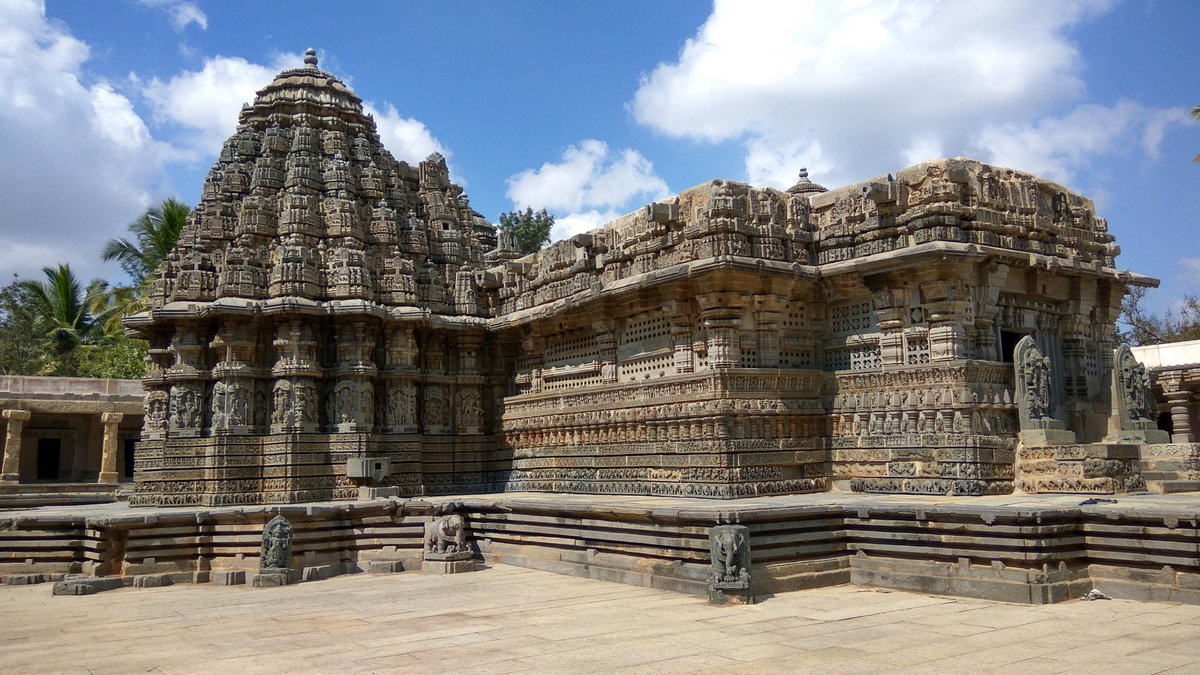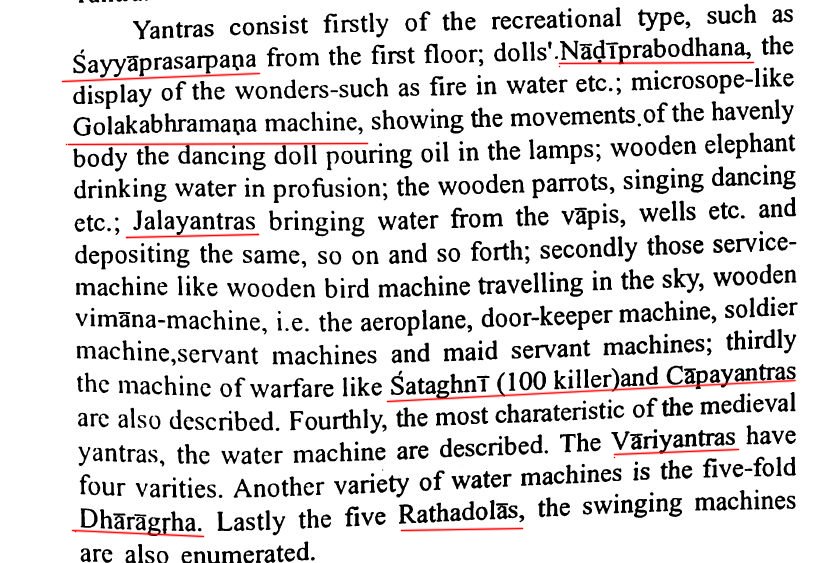A thread on the 800+ year old Airavateswara Temple at Darasuram, near Kumbakonam, TN. This temple dedicated to Lord Shiva was built by Rajaraja Chola II, the great grandson of the mighty emperor Kulottunga Chola. This temple is the most ornate of the 3 great living Chola temples. 







Temple gets its name from Lord Indra's Vahana, Airavata. The Sthalapurana of this place mentions that Airavata was once cursed by Durvasa muni for disrespecting him,which resulted in Airavata getting a skin discoloration,which is cured after he takes a bath at the Pushkarani here 

This is the Dwajasthambam facing the Garbhagudi, which houses a large magnificent Shiva Lingam. The mantapam seen in the background is on a elevated level. The steps leading up to the mantapam are filled with exquisite carvings of elephants & horse chariots & so are the pillars. 

The Elephant & Horse Ratha carving on the steps leading up the the elevated Mantapam. Like most Chola temples of the area, this too has been a victim of islamic iconoclasm. Many sculptures have suffered heavy damage as a result of islamic invasions. 



I'll take you through some of the murthis on the outer walls of the temple. Seen here is the Lingodbhavamurthy. The other two figurines encircled in red are Brahma in the form of a swan & Maha Vishnu in his Varaha avatar. The story behind his manifestation of Shiva is fascinating 



The Airavateswara Temple also houses the murthi of one of the rarest manifestation of Lord Shiva called Ardhanarisurya. This murthi(seen on the left) is often mistaken for Ardhanarishvara. But on closer inspection one can spot Lord Surya behind the 3 heads. Extremely rare. 



A murthi of fierce form of Shiva; Veerabhadra. Notice the flame like hair. He is wielding 4 different weapons in each of his 4 arms. They are Bana(arrow) in his rear right hand, Dhanusha(bow) in the rear left hand. In the front 2 arms he holds Khadga(sword) & a Khetaka(shield) 

Another murthi of Veerabhadra in his fierce 3 headed form. Notice the mustache. He is adorned by nagas in each arm & leg. & carries a weapon him each one of his hand. 



Seen here is another manifestation of Lord Shiva known as Bhikshatana murthy. Here is depicted as a Bhikshuka(beggar). Lord Shiva assumes this form to atone for the paapa of having severed Lord Brahma's 5th head,which he does in his Bhairava roopa. Seen in his left arm is a bowl. 



Above murthi is heavily damaged & missing many elements including a deer. Here's what an undamaged Bhikshatana looks like. He has 4 arms,front right arm feeding the deer with grass,back right arm holds a damaru,front left hand holds a kapala (bowl) back left hand holds a trishula 

Lord Shiva wanders all the 3 lokhas in the form of Bhikshatana & finally is relived of his paapa of having severed Lord Brahma's when he reaches Varanasi. You'd have heard of "Brahmahatya"...its associated with Bhikshatana.
Bhikshatanamurthy is located on the northern wall of the temple. Seen to the left is a murthi of Ganapathi. Another noteworthy carving here is a manifestation of Lord Shiva known as Gajasurasamhara, located a tier above. Shiva slays a rakshasha who assumes a form of an elephant . 



A murthi of Lord Shiva in his Kala Bhairava swaroopa. He is accompanied by his Vahana, Shvana(dog). He wields various asthras such as a trishula, khadga(sword), paasa(noose), khetaka(sheild) & a kapala(skull) which is actually Brahma's 5th head. Notice the naga around the waist 

The above murthi of Kala Bhairava is housed on the north wall of the temple. (1st murthi on the right in this pic) In the background is the entrance gopuram. 

The very 1st murthi on the northern wall of the temple(see previous tweet) is that of Lord Brahma. He holds a maala & kamandala in this front arms & has jata mukuta (matted hair) 
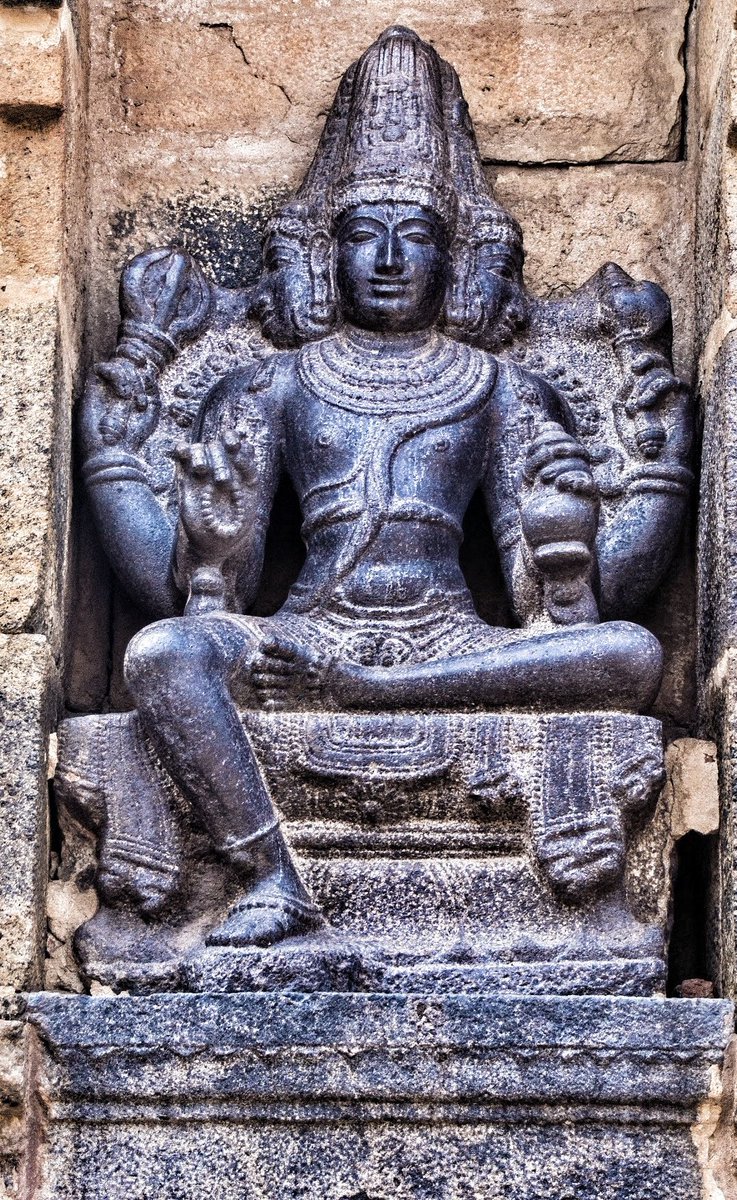
Scenes from the Ramayana at Airavateswara temple. A carving depicting Lord Rama taking aim at Vali as Sugreeva fights him. Also seen behind Lord Rama is Lakshmana with folded hands in reverence. 

A faded carving of Lord Shiva assuming the ferocious form of Veerabhadra & destroying sage Brighu's army singlehandedly. He wreaks havoc on Daksha's yajna after learning of Sati's dead. It finally ends in Veerabhadra decapitating Daksha's head. (punishment for insulting a woman) 

A highly faded carving of Lord Shiva manifesting as Kalasamharamurthy to save his bhakta Markandeya, who is seen clutching onto the lingam dearly. In the middle is Lord Yama who accidentally puts his noose around the lingam. Lord Shiva unleashes terrible fury on Yama. 

A murthi of the greatest of all rishis, Sage Agastya. He holds a maala in one hand & a kamandala in another. @HighOnFloyd 

A murthi of Nandi in human form. This specific form is known as Nandikeshwara. Notice a leaping deer in his rear left hand. He stands with his front arms in a folded position of reverence to Lord Shiva. 

A very elegant murthi of goddess Ganga. She is seen holding a lotus flower in her right hand & a pot of water in the left. The reverence people have for the Ganga river throughout ages in every part of Bharat.. 

On of the many ornately carved pillars at the mantapam. Notice the miniature carvings. These are no longer than a finger's length in height. Seen here is a miniature carving of Shiva with Nandi behind him. Also notice the Yali(part lion, part horse, part elephant) miniatures. 

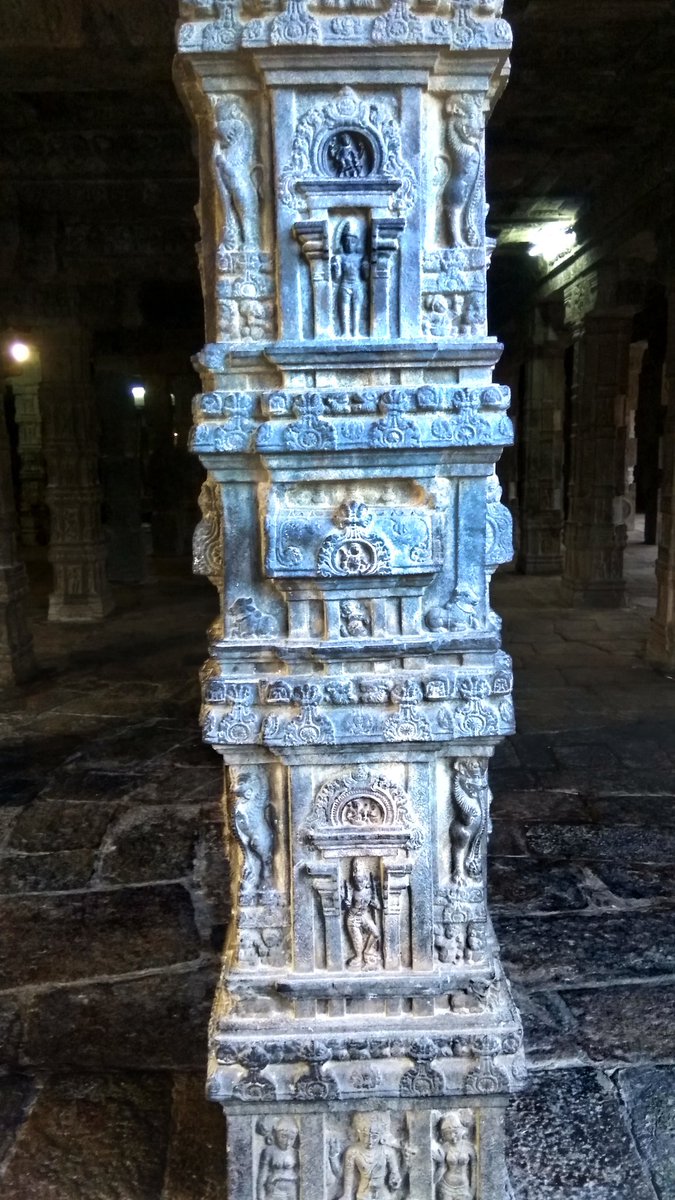

Carving on this pillar shows a seated Lord Shiva surrounded by his attendants, the ganas. Also seen are various animals including a deer on the right side bottom edge, a lion on the opposite side. Nandi is also seen behind Shiva. 

A fascinating optical illusion carving of a bull & an elephant sharing a common head. This type of carving was pioneered by the Cholas. 

Carving of a graceful Chola royal woman admiring herself in the mirror surrounded by her attendants. 

A mindblowing carving depicting a warrior seated on a Yali, a hybrid creature which is a mix of a Lion, an Elephant & a Horse. Also seen on the bottom right side is the terrific sea creature known as Makara. 

A carving of a fiery Lion & a Makara(sea creature on the bottom left) together overpowering an Elephant. 

There is also a seperate gudi dedicated to Chandikeshwara in the NE direction. He is one of the 63 nayanmars & the main guardian of temple wealth. Seen in the foreground is the Vimana of the Chandikeshwara gudi. In the background is the Vimana of Airavateswara. 

Devotees after performing pradikshanam(parikrama) to Lord Shiva stop over at the Chandikeshwara gudi & make some kind of noise(like snapping of fingers or a clap)to wake him from deep meditative state to tell him they r leaving the temple empty handed. (without stealing anything)
The magnificent Airavateswara Vimana which stands at 79 feet. Rajaraja II could have easily built the Vimana much taller than the ones built by his ancestors at Thanjavur & Gangaikonda Cholapuram... Yet didn't out of respect. Instead he focused on other aspects such as sculptures 
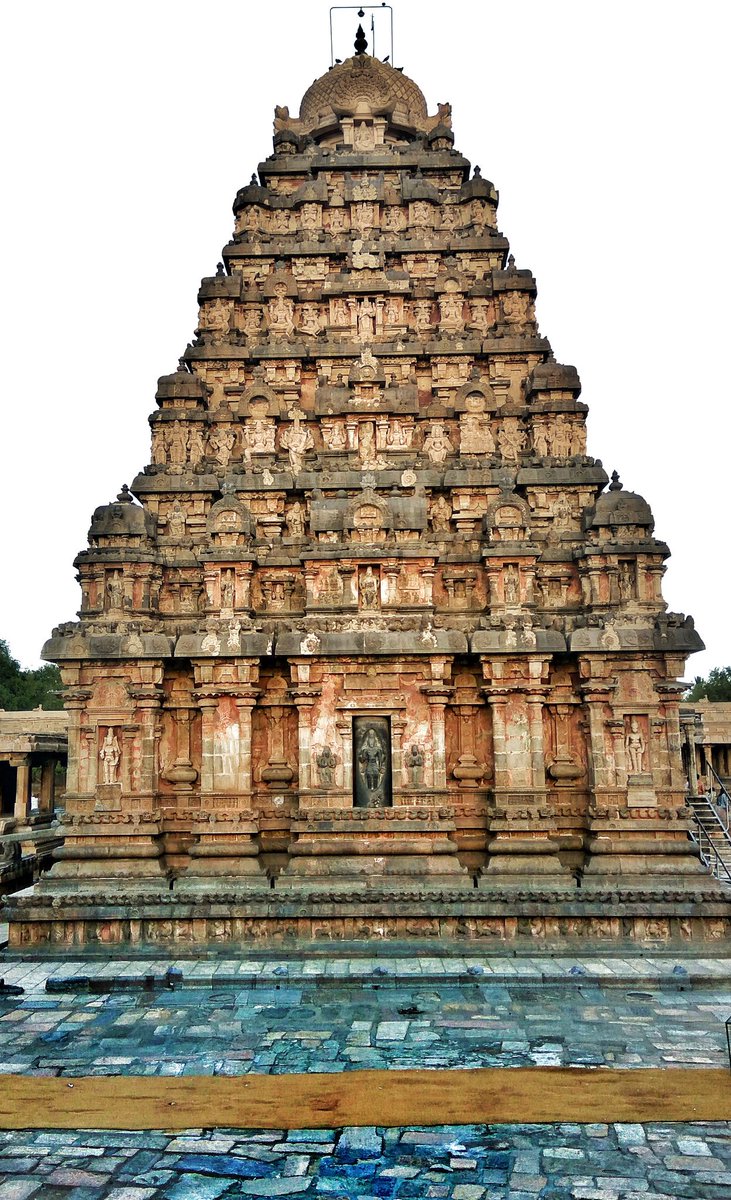
A carving of Lord Brahma being invited to preside over the marriage of Lord Shiva & Parvati Devi on one of the pillars. 

A miniature carving of Bhikshatana murthy on one of the pillars. Seen above it is a micro miniature carving of Ganesha, which is smaller than the size of a human thumb. 

A panel depicting a female bharatanatyam dancer flanked on either side by male percussionists. Notice how the piece of clothing dangling from the dancer's raised left arm sways in the air. 

A fascinating pillar carving depicting Lord Shiva seated on Nandi followed by on Indra on the Airavata(elephant) followed by Brahma on the Hamsa(swan) & finally Maha Vishnu on Garuda. Seen below them in the two tiers are the Ganas. The Cholas were highly artistic & imaginative. 

Deciphering extremely faded carvings such as the one seen here can be challenging & fun. To the left is Lord Shiva seen in his Gajasurasamhara(slaying elephant asura) form. In the middle are Ganesha & Skanda. To the right is Parvati in her Narayani swaroopam. 

Along the perimeter of the temple runs this lining of small Nandis. Every single Nandi has been decapitated by islamic invaders. Not one spared. This temple lay in ruins for centuries before restoration. 



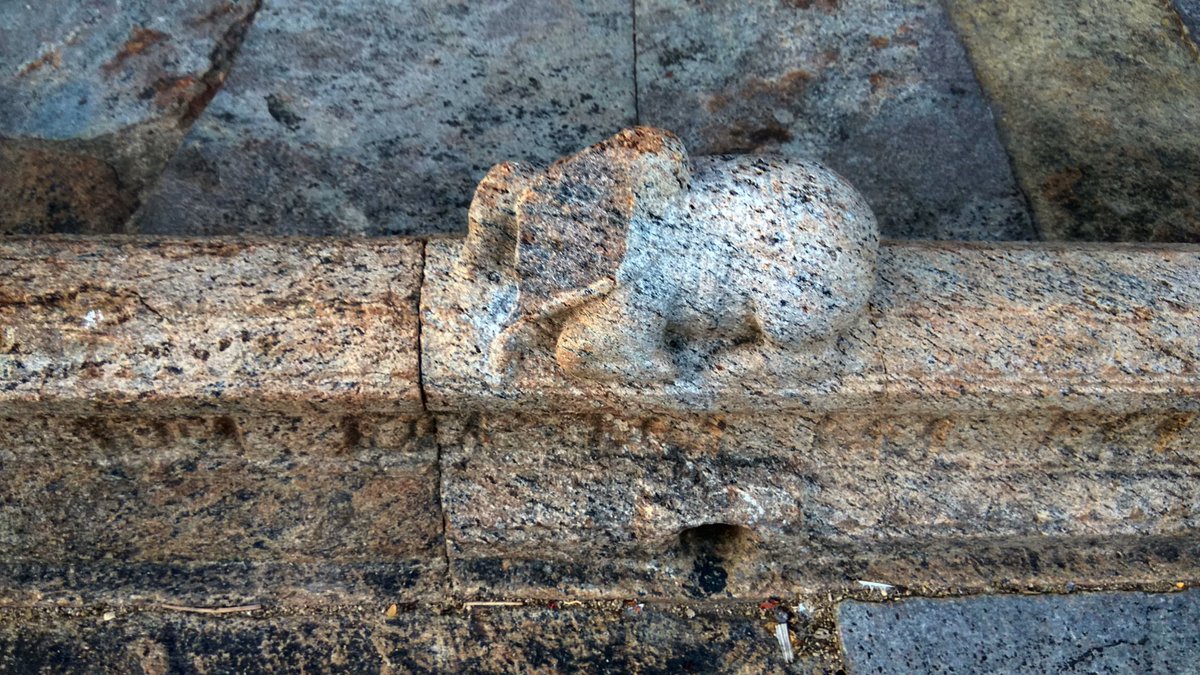

A series of carving depicting Ravana lifting the Kailasa parvata. He is eventually shown being granted darshan by Lord Shiva. 

A series of carving beautifully depicting an episode from Mahabharata. It is called Kiratarjuniya. Its a fight between Lord Shiva & Arjuna. Let me briefly explain the episode in the following tweets. 

During their exile period in the forest, Draupadi urges the Pandavas to declare war against against the Kauravas. While Bhima agrees.. Arjuna as usual is left in two minds & confused. The final word however was with Yudhishthira. He decides against any such action.
The confused Arjuna not knowing what to do proceeds to embark on a vigorous penance to please Lord Shiva. 

Lord Shiva decides to put Arjuna to the test & sends an asura called Mukasura to scuttle Arjuna's penance. Mukasura assumes a form of a wild boar & charges towards Arjuna. Meanwhile Lord Shiva too descends to Bhoolokha in the form of a Kirata(hunter).
An enraged Arjuna shoots an arrow at the charging Mukasura in an attempt to kill him for disturbing his penance. Simultaneously Kirata too shoots an arrow. It results in the death of Mukasura. Following this an argument ensues between Kirata & Arjuna as to who killed the boar.
What followed next was a ferocious battle between Arjuna & Kirata as depicted here. Its a epic battle that lasts of days. Arjuna despite his ace fighting skills isn't able inflict any damage on this hunter. He is left amazed. 

It finally dawns on Arjuna that he is fighting none other than Lord Shiva himself & surrenders. Pleased with Arjuna's bhakti, Lord Shiva grants Arjuna one of the most powerful weapons, the Pashupatasthra, which Arjuna eventually uses to kill evil Jayadratha at Kurukshethra. 

More tales of Bhakthi from the temple. This is a carving of Kanampulla Nayanar. He is one of 63 Shaivaite saints. A little background on him.... Kanampulla Nayanar was a great bhakta of Lord Shiva. He was a farmer by profession. He spent much of his wealth in serving Lord Shiva. 

Kanampulla Nayanar spent much of his wealth which mainly involved lighting thousands of deepams to Lord Shiva in many temples. Poverty soon struck him. He was forced to cut grass for a living. Yet he didn't waver in his devotion to Shiva. He kept lighting those deepams.
A famine once strikes the area due to which Kanampulla Nayanar isn't able to sell grass. He is left unable to light deepams for Lord Shiva. He does not give up. He prepares wicks made of dried grass & tries lighting it. But fails...
In a show of great bhakti he uses his own hair as a source of fire to light the deepams as the carving depicts. It is for this great bhakti that Kanampulla Nayanar is revered as a great saint.He along with 62 other saints were responsible for revival of Hindu Dharma in the region
• • •
Missing some Tweet in this thread? You can try to
force a refresh























